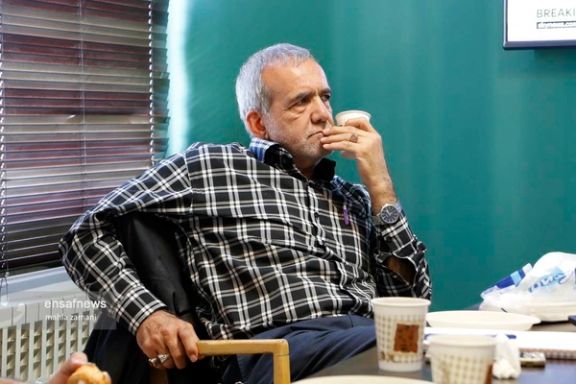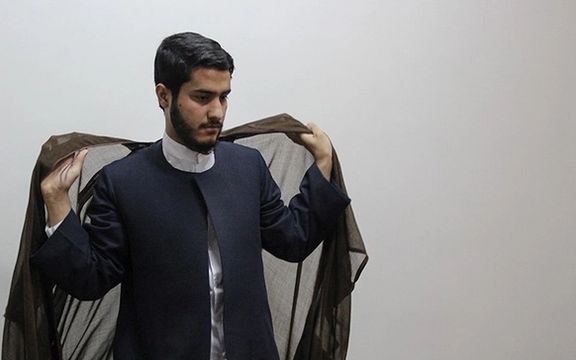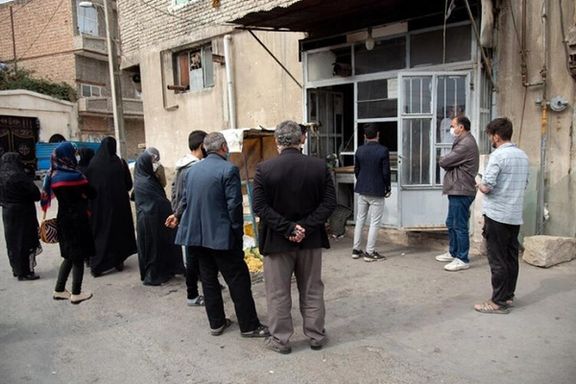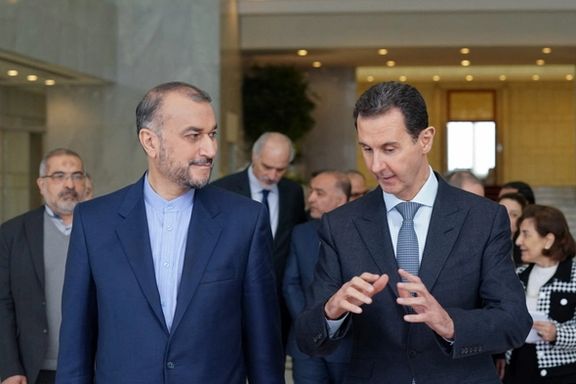Lawmaker Says Many Iranian Academics Want To Leave The Country

An Iranian lawmaker says many university professors have applied for retirement or are planning to leave the country amid economic hardships.

An Iranian lawmaker says many university professors have applied for retirement or are planning to leave the country amid economic hardships.
Reformist member of Parliament from Tabriz Massoud Pezeshkian told ILNA on Wednesday that despite the call by Supreme Leader Ali Khamenei to boost innovation, nothing special will happen in academia until authorities change their views and perspectives.
Khamenei designated the new Iranian calendar year of 1401 (started on March 21) as the year of knowledge-based productivity and job creation.
Khamenei has been designating slogans for each year in the past decade, such as “Leap in Production” and this year his motto became innovation and knowledge based economic growth.
Officials will face an uphill battle implementing this slogan because most of the things that the parliament has approved are not practical or science-based and would further restrict universities in innovation and employment, Pezeshkian noted.
Pezeshkian added that when the parliament, the presidential administration and the judiciary choose private sector contractors for projects, you cannot encourage the academics to stay in the government universities to boost efforts with the same salary.
In addition to all this, universities are also firing many of professors in what critics see as further political cleansing of academia.
Iran’s Azad University has fired 325 professors and lecturers in recent months and has decided to dismiss 1,500 more.

This article is the second in a series about Iran’s Shiite clerics, explaining how they study, get a clerical rank, get married and what they do for a living.
-------------------------------------------------------------------------------------------------------------------------
-Getting into the clerical robe and putting the turban on the head requires the completion of the introductory seminary courses and passing an easy exam which is mainly about ideology and ethics.
Clerical students usually put on a shirt without a collar and a pair of regular pants – no jeans. Putting on the robe and the turban is a turning point in the life of a young cleric. The turban or ammameh must be placed on the young cleric's head by a prominent clergyman or one highly respected by the students at the madrassah.
Once the young clergyman gets into the clerical outfit, he no longer is allowed to wear anything with a bright color. His shoes must be modest and devoid of any ornamentation. Most senior clerics frown at a young cleric with a wristwatch. They never wear it. However, in recent years, one might come across exceptions.
Generally, a typical cleric will walk and talk slower and dress more modestly once he gets his robe and turban. It is at this point that some clerics put on white turbans while others who are a seyyed or alleged descendants of the prophet will wear black turbans as a symbol of mourning for the martyred Imams particularly the third imam, Hussain

The clerical outfit usually consists of a turban and a robe, and two long and short jackets (labbadeh and qaba) put on under the robe, a delicate pair of white thin trousers and finally a pair of slippers (na'lain). If they have to wear shoes, shoelaces are frowned at and seen as a sign of immodesty.
Many clerics with hair loss, attribute it to the turban which is placed on their head all day and during part of the night. Most clerics traditionally keep their hairs short. After the 1979 revolution, many clerics, including Supreme Leader Ali Khamenei are not so keen to have regular haircuts. Some, again including Khamenei, allow a bit of hair to slip out of the turban on their forehead. These are believed by other clerics to be more modern, which is not necessarily a good trait.
Forcing a smile is good but a laughter is not supposed to be heard. Former President Hassan Rouhani was often criticized even by colleagues and fellow clerics for his laud laughter.
Although modern clerics usually go to see their relatives and sometimes have gatherings of family and close friends at their home, many older clerics rarely go for a visit to a friend or relative's house. The younger ones, mix with the rest of the family more often, although in most of their parties they shed their clerical outfit and get into something more secular.

Most clerics frown at traditional occasions for a family get together such as Nowruz (the New Year) or Yalda, (the longest night of the year). Nonetheless, younger clerics who have joined the ranks of akhunds during in the past two decades, celebrate the festive seasons like most other people.
However, many clerics have complained that they find it increasingly difficult to show up at shopping centers or the streets. Many Iranians, fed up with clerical rule, can hardly differentiate between those in the government and others who are teachers, or pastoral work or have small jobs here and there. Consequently, when they see them, they begin to voice their frustration and anger or at least try to tease a mullah.
Until some 40 years ago, most clerics and their families were familiar with concepts of andarouni (private interior) and birouni (less private exterior) in their homes which determined where the clerics could behave more comfortably, and where they had to be weary of prying. Nowadays, with smaller houses and flats these concepts have faded out and many occasions young and poor clerics find their dignity and privacy compromised.
If they are not rich enough to drive their own car or to be driven to work, taking a taxi is a nightmare for any cleric. Most taxi drivers prefer not to give a ride to an akhund. Or if they do, they most likely want to embarrass him in front of other passengers as taxis in Iran sometimes have up to five people on board.
During the fasting month of Ramadan and the mourning months of Muharram and Safar many young clerics travel to the provinces for "Islamic propagation." Most of the time, they are paid by the seminary or the government, while the pious local merchants also make sure that the visiting cleric is taken good care of and is paid good money by local businesses.
Youngsters in the provinces, however, fail to differentiate between these poor clerics who are dispatched to instill the party line and the Islamic Republic ideology among provincials. They constantly tease the mullahs for eating too much or having big pockets to collect easy money, or for wasting government resources. And the mullahs fail to understand that even villagers in Iran have access to satellite TV and foreign broadcasts which make them different from villagers in the past who took as fact whatever was uttered by a cleric.

Three former senior Trump administration officials say removing Iran’s IRGC from the US list of foreign terrorist organizations (FTO) is “a dangerous capitulation".
In a joint statement exclusively shared with Axios on Tuesday, former Secretary of State Mike Pompeo, Director of National Intelligence John Ratcliffe, and national security advisor Robert C. O'Brien said the move would be “a denial of the basic reality that the IRGC's core mission is to spread terror".
Quoting the US Intelligence Community Annual Threat Assessment issued last month, they reiterated that Iran is a threat to US persons directly and via proxy attacks and "previously attempted to conduct lethal operations in the United States."
“These assessments, combined with the IRGC's lengthy history of killing hundreds of Americans…make it clear: The IRGC is a terrorist organization and should remain labeled as such," they said.
“The pursuit of an ill-conceived ‘deal’ should not compel American leaders to acquiesce to the demands of a terrorist regime to deny the truth. American lives are at stake, and this is a time to project strength, not weakness."
Republican lawmakers are raising objections to removing the IRGC from the US terror list. In their latest effort, 87 representatives wrote a letter to Secretary of State Antony Blinken, urging him not to remove the IRGC from the list, saying the IRGC "is one of the most dangerous terrorist groups in the world today.

Prolongation of the Ukraine war may affect Iran's supplies of wheat, corn, vegetable oil, livestock feed, and fertilizer ingredients, pushing up prices.
Iran imports sunflower oil, wheat, corn, barley, and soybeans as well soybean meal for animal feed from Russia and Ukraine.
The volume of Iran's imports from Russia is much higher than from Ukraine. Iran's imports from Russia totaled around $1.8 billion in the first ten months of the previous Iranian calendar year which began on March 21, 2021, whereas during the same period it imported only around $162 million from Ukraine.
Nour News, which is affiliated with the secretary of Iran's Supreme National Security Council (SNSC), Ali Shamkhani, said last week that Iran’s agriculture minister, Javad Sadatinejad, signed an agreement during a recent visit to Russia to import 20 million tons of basic goods, including vegetable oil, wheat, barley and corn.
The report said the deal is to address concerns about shortages of basic goods and livestock feed in the coming months but did not mention the monetary value of the deal.
According to the US Department of Agriculture, Russia and Ukraine together account for a third of the world’s wheat exports, a fifth of its corn trade and almost 80 per cent of sunflower oil production. All three items are among Iran's imports of major essential goods.

Russia has announced additional restrictions on grain exports to ensure its own food security and to protect the domestic market.
Iran's production of wheat is likely to be around 30 percent less this year due to expected lower rainfall. According to the chairman of Federation of Iranian Food Associations, Mohammadreza Mortazavi, Iran needs to import around 3.5 million metric tons of wheat by early March. Mortazavi said importing wheat would not be a problem, but the cost will be higher.
The burden of higher costs of wheat imports will fall on the already cash-squeezed government of President Ebrahim Raisi. Earlier in March the parliament scrapped $15 billions of subsidies for imports of all essential goods except wheat, to keep the price of bread, a main staple for Iranians, steady at bakeries.
Iran’s Feed and Grain Importers Union has recently announced that the Russian invasion can also cause problems in the imports of livestock feed and grain because companies cannot keep their deliveries due to logjams in supply chains.
Soybean meal, barley and corn are imported from Russia and other countries mainly for livestock and chicken feed. Iran annually imports around 8 million metric tons of corn, 4.2 million metric tons of soybean meal, and 400,000 metric tons of barley for animal feed. Any shortages or higher prices can push up the price of meat.
The chairman of Iran-Brazil Chamber of Commerce, Fakhreddin Amerian, last month said 60 percent of Iran's corn imports originated in Brazil and the rest came from Ukraine and Russia. Amerian said a shortage of corn was not likely as more could be imported from Brazil and other sources.
On March 4 Russia’s trade and industry ministry recommended the country’s fertilizer producers temporarily halt exports, which may increase the already sky-high fertilizer prices.
Although Iran produces most of its fertilizer domestically, it imports the ingredients from various countries such as China, India, and Turkey. Higher fertilizer prices could also hugely affect the prices of rice, fruits and vegetables in Iran. Fertilizers account for around 70 percent of the production cost of rice, the most important staple food after bread in Iran.

Iran’s foreign minister visited Syria Wednesday to discuss the latest regional developments and reportedly the Russian invasion of Ukraine.
Heading a delegation, Hossein Amir-Abdollahian arrived in Damascus and was received by his Syrian counterpart Faisal Mekdad.
During a press conference, Amir-Abdollahian said that the Islamic Republic and world powers are closer than ever to reviving the 2015 nuclear deal.
He also said Tehran welcomes new talks between Syria and certain Arab countries, referring to President Bashar Assad’s visit to the United Arab Emirates last week, his first to an Arab country since the Syria war broke out.
Amir-Abdollahian said relations between Iran and Syria are in their best state, and called for more economic and trade cooperation.
Highlighting Iran’s close alliance with Syria, he said, “We are in the same trench, and we support Syria’s leadership, government and people.”
Mekdad told reporters at Damascus airport that among the issues on the agenda of his visit was the situation in Ukraine.
“We will discuss the huge developments today after Russia’s military operation in Ukraine. We will discuss what is behind that and we will discuss our mutual stances toward these developments”, Mekdad said.
Russia is recruiting fighters in Syria to fight in Ukraine, a move that can bring Iran-backed fighters into the war in Europe.
There are a myriad of groups fighting in Syria, including locals fighting for Iran and Bashar al-Assad’s forces, the Lebanese Hezbollah, Afghan and Iraqi fighters recruited and paid by Iran, and Jihadist groups opposed to Iran and Russia.

Israel should forsake “mischief” against Iran or face “revenge,” Hossein Salami, commander of Iran’s Revolutionary Guards told a memorial gathering Wednesday.
“We do not just hold funeral services for our martyrs - we also take revenge,” Salami told a memorial service for a veteran IRGC officer, Mohammad-Hassan Kusehchi, a Dezful native, who died of illness in March 2021. “These are real and serious messages.”
Major-General Salami described the new century, in the Iranian calendar, as a period of decline for the West: “The end of America and western civilization began many years ago. In addition, the revolutionary movement has continued and accelerated in recent years.”
While Israeli attacks go back to killing nuclear scientists from 2010 to 2020, and include June 2021’s attack on a nuclear facility at Karaj, there has been a recent escalation. In February, an Israeli aerial strike reportedly destroyed hundreds of drones at an airbase in Kermanshah province, and March 7 an Israeli airstrike near Damascus killed two Iranian officers in the latest of hundreds of Israeli airstrikes on Iranian forces in Syria since 2017.
The apparent response was Tehran's recent missile attack on Iraq’s Erbil, where Iran fired 12 ballistic missiles saying it targeted an Israeli secret base. Some Iran-backed sources said the Erbil attack killed several people but according to Iraqi officials no one was killed.